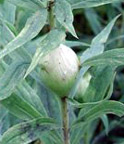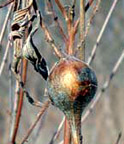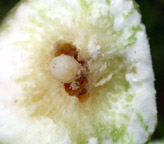Galls
Look for galls on leaves and stems. If you see one, you know an insect has been there.
What are galls? Galls are a plant's response to an injury or a foreign object, such as a small animal. Some people think that galls are plant scar tissue that forms around the injury. Gall formation is not entirely understood, but it is more than just scar tissue. The insect or mite in the gall apparently causes the plant to form a gall.
An insect or might lays eggs on or in plant tissues. The plant responds by forming a gall at that site.
ccw
One very common gall in North America is the goldenrod gall. This gall is formed when a female goldenrod gall fly lays an egg in the stem of the plant.






